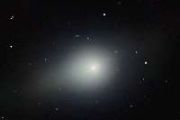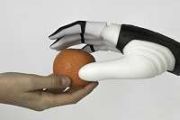
Copernical Team
Asteroid 'Apophis' predicted to skim dangerously close to Earth in 2029
 Earlier, NASA said that Apophis - the poster child for "hazardous asteroids" - was no longer deemed a threat for Earth based on a refined estimate of its orbit around the Sun.
Asteroid 99942 Apophis, estimated to measure 340 metres (1,100 ft) across and identified by the National Aeronautics and Space Administration (NASA) as one of the most hazardous asteroids that could impact Earth, wil
Earlier, NASA said that Apophis - the poster child for "hazardous asteroids" - was no longer deemed a threat for Earth based on a refined estimate of its orbit around the Sun.
Asteroid 99942 Apophis, estimated to measure 340 metres (1,100 ft) across and identified by the National Aeronautics and Space Administration (NASA) as one of the most hazardous asteroids that could impact Earth, wil Quadrantid meteor shower offers good show outside of North America
 The Quandrantid meteor shower helped kick off the first workday of the new year on Monday, with the peak somewhat tough to see in North America - but the rest of the world got a good show.
The "Quads" as they are nicknamed, are slated to peak around 4 p.m. EDT (2100 GMT) on Monday, according to Margaret Campbell-Brown and Peter Brown in the 2022 version of the Observer's Handbook of th
The Quandrantid meteor shower helped kick off the first workday of the new year on Monday, with the peak somewhat tough to see in North America - but the rest of the world got a good show.
The "Quads" as they are nicknamed, are slated to peak around 4 p.m. EDT (2100 GMT) on Monday, according to Margaret Campbell-Brown and Peter Brown in the 2022 version of the Observer's Handbook of th How scientists designed the orbit of the Chang'E 5 mission
 In the early morning of November 24, 2020, the Chang'E 5 lunar probe was launched from the Wenchang Space Launch Center and successfully executed a 23-day journey of lunar sample return (LSR) mission. In a review paper recently published in Space: Science and Technology, Dr. Zhong-Sheng Wang and his colleagues from the Beijing Institute of Spacecraft System Engineering, addresses three key orbit
In the early morning of November 24, 2020, the Chang'E 5 lunar probe was launched from the Wenchang Space Launch Center and successfully executed a 23-day journey of lunar sample return (LSR) mission. In a review paper recently published in Space: Science and Technology, Dr. Zhong-Sheng Wang and his colleagues from the Beijing Institute of Spacecraft System Engineering, addresses three key orbit China's Mars orbiter captures series of selfies using remote camera
 The China National Space Administration released photos on New Year's Day, of its Mars orbiter circling high above the Red Plant.
The selfies were taken by a small camera which was deployed by the Tianwen 1, capturing images of the orbiter and sending them back to it via a WiFi connection.
The photos were then relayed back to Earth where they were published by China's space agenc
The China National Space Administration released photos on New Year's Day, of its Mars orbiter circling high above the Red Plant.
The selfies were taken by a small camera which was deployed by the Tianwen 1, capturing images of the orbiter and sending them back to it via a WiFi connection.
The photos were then relayed back to Earth where they were published by China's space agenc Sols 3347-3348: Bem Vindo a Roraima!
 Tosol, Curiosity woke up in a new mapping quadrant, Roraima. The Roraima quadrant is named after the northern-most state of Brazil and Mount Roraima, which is the highest peak in the Pakaraima mountains which sits between Brazil, Venezuela, and Guyana.
The terrain in the Roraima region on Earth looks somewhat similar to the area Curiosity is in - with flat-topped hills and some steep slope
Tosol, Curiosity woke up in a new mapping quadrant, Roraima. The Roraima quadrant is named after the northern-most state of Brazil and Mount Roraima, which is the highest peak in the Pakaraima mountains which sits between Brazil, Venezuela, and Guyana.
The terrain in the Roraima region on Earth looks somewhat similar to the area Curiosity is in - with flat-topped hills and some steep slope Flight 19 - New Year, Same Ingenuity
 The next flight on Mars marks the first of 2022 and the nineteenth for NASA's Ingenuity Mars Helicopter. The current mission goal is to reach the Jezero river delta to aid the Perseverance rover in path planning and scientific discovery.
This flight, which will take place no earlier than Friday, Jan. 7, takes the scout vehicle out of the South Seitah basin, across the dividing ridge, and u
The next flight on Mars marks the first of 2022 and the nineteenth for NASA's Ingenuity Mars Helicopter. The current mission goal is to reach the Jezero river delta to aid the Perseverance rover in path planning and scientific discovery.
This flight, which will take place no earlier than Friday, Jan. 7, takes the scout vehicle out of the South Seitah basin, across the dividing ridge, and u China plans missions to moon's south pole
 China has approved the fourth phase of its lunar exploration program, including a basic model of a research station built on the moon over the coming decade, according to the China National Space Administration.
Wu Yanhua, deputy director of the administration, said China would carry out lunar exploration in the future Chang'e-6, Chang'e-7 and Chang'e-8 missions.
As planned, Chang'e-
China has approved the fourth phase of its lunar exploration program, including a basic model of a research station built on the moon over the coming decade, according to the China National Space Administration.
Wu Yanhua, deputy director of the administration, said China would carry out lunar exploration in the future Chang'e-6, Chang'e-7 and Chang'e-8 missions.
As planned, Chang'e- Resolving the black hole 'fuzzball or wormhole' debate
 Black holes really are giant fuzzballs, a new study says. The study attempts to put to rest the debate over Stephen Hawking's famous information paradox, the problem created by Hawking's conclusion that any data that enters a black hole can never leave. This conclusion accorded with the laws of thermodynamics, but opposed the fundamental laws of quantum mechanics.
"What we found from strin
Black holes really are giant fuzzballs, a new study says. The study attempts to put to rest the debate over Stephen Hawking's famous information paradox, the problem created by Hawking's conclusion that any data that enters a black hole can never leave. This conclusion accorded with the laws of thermodynamics, but opposed the fundamental laws of quantum mechanics.
"What we found from strin Sunshield deploys on NASA's Next Flagship Telescope
 The James Webb Space Telescope team has fully deployed the spacecraft's 70-foot sunshield, a key milestone in preparing it for science operations. The sunshield - about the size of a tennis court at full size - was folded to fit inside the payload area of an Arianespace Ariane 5 rocket's nose cone prior to launch. The Webb team began remotely deploying the sunshield Dec. 28, 2021, three days aft
The James Webb Space Telescope team has fully deployed the spacecraft's 70-foot sunshield, a key milestone in preparing it for science operations. The sunshield - about the size of a tennis court at full size - was folded to fit inside the payload area of an Arianespace Ariane 5 rocket's nose cone prior to launch. The Webb team began remotely deploying the sunshield Dec. 28, 2021, three days aft Space business: The final (profitable) frontier
 The snub-nosed craft resembles a shuttle-airplane mashup, and is the latest entrant in a profit-seeking push with staggering potential - and risks - for humans to visit, work or even live in space.
The display of technology like the life-size model "Dream Chaser" ship at the CES tech show in Las Vegas is a sharp signal that the commercial space era is upon us.
Experts see a path for
The snub-nosed craft resembles a shuttle-airplane mashup, and is the latest entrant in a profit-seeking push with staggering potential - and risks - for humans to visit, work or even live in space.
The display of technology like the life-size model "Dream Chaser" ship at the CES tech show in Las Vegas is a sharp signal that the commercial space era is upon us.
Experts see a path for 



























